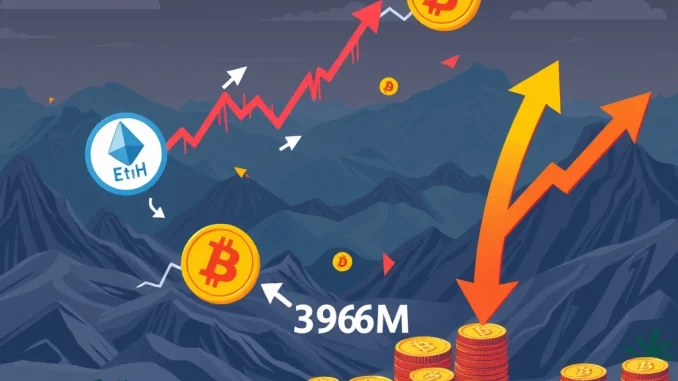
The cryptocurrency market is a place of constant movement and significant opportunity, but it also carries substantial risk. One key indicator of this volatility and risk is crypto liquidation data, particularly within the realm of perpetual futures trading. When traders use leverage, even small price swings can lead to positions being automatically closed out by exchanges to prevent losses exceeding the initial margin. This process is called liquidation, and the data provides a snapshot of market sentiment and recent price action.
Understanding Crypto Perpetual Futures and Liquidation
Before diving into the numbers, let’s quickly touch upon what we’re looking at. Perpetual futures are a type of derivative contract that allows traders to speculate on the future price of an asset without an expiry date. They are popular because they enable the use of leverage, meaning traders can control a large position with a relatively small amount of capital.
However, leverage is a double-edged sword. While it can amplify profits, it also magnifies losses. If the market moves against a leveraged position to a certain point (the liquidation price), the exchange will automatically close the position. This is liquidation. High liquidation volumes often signal periods of sharp price movements and increased market volatility.
Recent Crypto Liquidation Data: A 24-Hour Snapshot
Looking at the past 24 hours provides a clear picture of recent market activity. A significant amount of capital was wiped out across various assets through crypto liquidation data.
Here’s the breakdown of perpetual futures liquidations:
- ETH: $237.06 million liquidated
- BTC: $141.26 million liquidated
- SOL: $17.88 million liquidated
In total, approximately $396 million in leveraged positions were closed out in just one day across these three major cryptocurrencies alone. This figure highlights the dynamic nature of the market and the risks associated with high leverage.
Key Observations from ETH Liquidation
Ethereum saw the highest volume of liquidations, totaling $237.06 million. A crucial detail within this figure is that 76.78% of these liquidations were long positions. What does this mean? When long positions are liquidated, it typically occurs because the price of the asset has fallen significantly. Traders who bet on ETH’s price going up were forced out of their positions as the market moved downwards. This high percentage of long liquidations suggests a notable downward price movement for Ethereum over the period.
What the BTC Liquidation Data Reveals
Bitcoin, the market leader, experienced $141.26 million in liquidations. Interestingly, the majority of these were short positions, accounting for 66.88%. Short positions are liquidated when the asset’s price increases. Traders who were betting on BTC’s price falling were caught out by an upward price movement. This indicates that while ETH might have seen downward pressure, BTC likely experienced a rally or significant upward price volatility during the same 24 hours, liquidating short sellers.
Insights from SOL Liquidation
Solana also contributed to the total, with $17.88 million in liquidations. Similar to Ethereum, the majority (65.31%) were long positions. This suggests that SOL also likely experienced a price dip, causing leveraged long traders to be liquidated. While the total volume is less than ETH or BTC, it still represents a significant amount for the Solana ecosystem.
Why Does This Crypto Liquidation Happen?
The primary driver behind these large liquidation numbers is the combination of leverage and market volatility. Traders use leverage hoping to increase potential profits, but this also increases their exposure to risk. When prices move sharply, either up or down, it quickly pushes leveraged positions to their liquidation price, triggering the automatic closure by the exchange.
Factors contributing to volatility can include macroeconomic news, regulatory developments, large whale movements, or even cascading liquidations themselves (where one wave of liquidations triggers others as prices move further). Monitoring perpetual futures liquidation data can offer insights into recent market direction and potential areas of support or resistance as ‘liquidation clusters’ can sometimes act as magnets for price.
Actionable Insights from Perpetual Futures Liquidation
What can traders learn from this data? Firstly, it’s a stark reminder of the risks of high leverage in the crypto market. Managing risk is paramount. Secondly, analyzing the dominant direction of liquidations (long vs. short) can give clues about recent market sentiment and price trends. For example, a high volume of long liquidations points to recent downward price action, while high short liquidations indicate upward movement.
For those not actively trading with leverage, this data still offers value. It helps gauge overall market health and volatility. Large liquidation events can sometimes precede periods of increased stability as excess leverage is removed from the system, or they can signal continued choppiness.
Understanding ETH liquidation, BTC liquidation, and SOL liquidation data individually and collectively provides a more complete picture of which assets are facing the most pressure and from which direction.
Conclusion
The past 24 hours saw a substantial amount of capital, roughly $396 million, wiped out through crypto liquidation in perpetual futures markets, primarily affecting ETH, BTC, and SOL traders. The data reveals that Ethereum and Solana experienced significant liquidations of long positions, indicating price drops, while Bitcoin saw substantial short liquidations, suggesting an upward price move. This breakdown underscores the inherent volatility and risks of leveraged trading in the crypto space and highlights the importance of sound risk management practices for all market participants.



